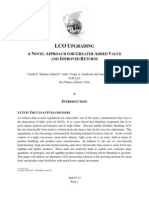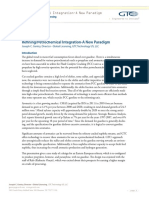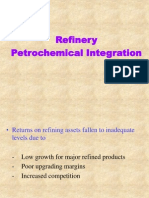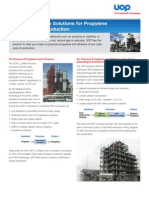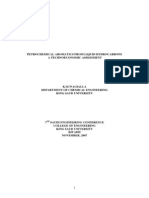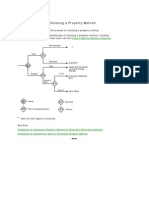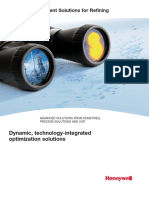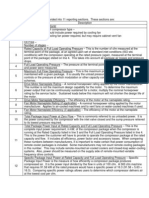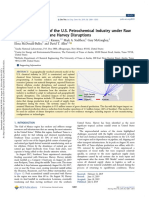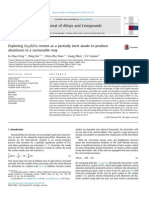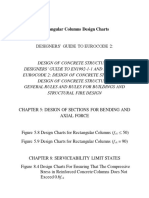GTC RefiningPetrochemical Integration
GTC RefiningPetrochemical Integration
Uploaded by
Karem Jeanette Saenz BernalCopyright:
Available Formats
GTC RefiningPetrochemical Integration
GTC RefiningPetrochemical Integration
Uploaded by
Karem Jeanette Saenz BernalCopyright
Available Formats
Share this document
Did you find this document useful?
Is this content inappropriate?
Copyright:
Available Formats
GTC RefiningPetrochemical Integration
GTC RefiningPetrochemical Integration
Uploaded by
Karem Jeanette Saenz BernalCopyright:
Available Formats
Engineered to Innovate
Refining/Petrochemical Integration-A New Paradigm
Joseph C. Gentry, Director - Global Licensing
Joseph C. Gentry, Director - Global Licensing, GTC Technology US, LLC
jgentry@gtctech.com www.gtctech.com
1001 South Dairy Ashford Suite 500 Houston, TX 77077, USA
page 1
Introduction
Te global trend in motor fuel consumption favors diesel over gasoline. Tere is a simultaneous
increase in demand for various petrochemicals such as propylene and aromatics. Technology provid-
ers have been successful to utilize the Fluid Catalytic Cracking (FCC) unit as a method to produce
propylene by high severity operation, but the gasoline yield from these units has been neglected.
Cat cracked gasoline contains a high level of olens, some sulfur, and appreciable aromatics. Until
now, the aromatics were not wanted due to the olen and sulfur impurities in this stream. New
technology is being commercialized to separate the aromatics from FCC gasoline in order to use them
directly for downstream applications. Additionally, the olen fraction can be converted into aromatics
through a simple xed-bed reaction system. Tus all of the gasoline components are e ciently made
into high-value petrochemicals. Tis combination of technology is much more e cient than methods
that some Middle Eastern operators use, which recycles FCC gasoline to the reforming unit.
For the aromatics, it is a fast growing market. CMAI (acquired by IHS in 2011) in 2005 forecast
benzene demand to grow at 4.1% per year between 2000 and 2020, resulting in total demand growth
of 24.3 million tons.
1
Mixed xylenes capacity will approximately double by 2020 to meet the strong
anticipated demand growth, mainly driven by the strong demand for polyester, for which Strategic
Business Analysis, Ltd. reports historical growth rates of 7% per year for the years 1997-2007, and
over 6% per year for the upcoming 10-year period of time.
2
Since the demand for gasoline is gener-
ally declining, and the specications for gasoline disfavor excessive aromatics, it is logical to convert
gasoline components into aromatics.
Terefore, signicant amounts of aromatics can be recovered from the renery cracked naphtha streams,
and technology exists to recover these aromatics for use as a petrochemical feedstock. Tis can be
done while oering the potential to produce incremental low cost aromatics and light olens from
alternative feed sources. Tis approach also synergistically reduces the sulfur and olens content in
the gasoline moving towards an environmentally acceptable specication and oers the opportunity
to rebalance the gasoline supply/demand in certain regions. It also frees naphtha reformer capacity to
accept fresh feed naphtha, thus increasing the overall aromatics production and hydrogen generation.
Tis presentation gives a case study of an Eastern European renery, which is being re-congured to
produce propylene, benzene, and paraxylene, with no gasoline. Te material is jointly prepared with
Rafo (Ranerie Oneti), which was excited about their prospects for earning a higher margin on
crude oil processing.
Refning/Petrochemical Integration-A New Paradigm
Joseph C. Gentry, Director - Global Licensing, GTC Technology US, LLC
Engineered to Innovate
Refining/Petrochemical Integration-A New Paradigm
Joseph C. Gentry, Director - Global Licensing
Joseph C. Gentry, Director - Global Licensing, GTC Technology US, LLC
jgentry@gtctech.com www.gtctech.com
1001 South Dairy Ashford Suite 500 Houston, TX 77077, USA
page 2
High-Severity FCC
High-severity FCC is intended to increase olen yields, driven by the fast growing global demand for
propylene. Te propylene yields can be increased from 3-5% in conventional FCC to 15-28%. In
high-severity FCC operation, the aromatic content in the cracked naphtha is 50-70%, which is suit-
able for aromatics recovery, but it contains signicant amounts of thiophenic sulfur impurities and is
highly olenic.
What Happened to FCC Gasoline Traditionally?
Typical FCC gasoline sulfur ranges from 1000 to 2000 ppm and is the dominate source of sulfur
in the typical gasoline pool. FCC gasoline desulfurization is required to meet the tight gasoline
regulation. To eectively reduce the sulfur content and minimize the impact within the renery,
it is necessary to understand the olen and sulfur distribution, olen structure and octane loss.
Table 1 shows the sulfur distribution and type with carbon number in a typical FCC gasoline. Te
light ends are very low in sulfur with mercaptan being the major sulfur specie, while heavy ends are
very high with thiophene being the major sulfur specie. Typically the olens are concentrated in the
light fraction with low olens in heavy ends.
Te sulfur content can be reduced considerable by hydrodesulfurization (HDS). Te olens are
consequently saturated which causes octane loss and hydrogen is consumed. Figure 1 is a traditional
Carbon No.
(boiling range)
Mercaptan % Sulfde % Thiophene %
C
4
2.23 4.27 3.96
C
5
4.16 0.67 15.02
C
6
4.81 5.49 24.83
subtotal 11.20 10.43 43.81
C
7
- 9.60 11.25
C
8
- 5.34 6.66
C
9
- - 1.07
subtotal - 14.94 19.00
C
10
- - 0.31
C
11
- - 0.31
subtotal - - 0.32
Total 11.20 25.40 63.4
Table 1. Sulfur distribution and type, according to carbon number, in a typical FCC gasoline
Engineered to Innovate
Refining/Petrochemical Integration-A New Paradigm
Joseph C. Gentry, Director - Global Licensing
Joseph C. Gentry, Director - Global Licensing, GTC Technology US, LLC
jgentry@gtctech.com www.gtctech.com
1001 South Dairy Ashford Suite 500 Houston, TX 77077, USA
page 3
Figure 1 Optimized three stage-stage process in traditional FCC gasoline desulfurization
ULS
Gasoline
Blending
(optional)
C
5
-iC
6
-
LCN
MCN
70150 C
150 C-EP
HCN
Caustic
Extraction
Mild HDS
Severe HDS
Medium HDS
C
6
-C
9
Olefns Sulfur
Saturation
(unavoidable)
Desulfurization
(needed)
FCC
Naphtha
three-stage FCC gasoline desulfurization process to remove sulfur and minimize octane loss. FCC
naphtha is rst separated into three fractions by distillation. Since the primary sulfur content in
the light cut naphtha (LCN) is mercaptan, a caustic extraction process is very eective to remove
them. Alternatively, mild HDS can be used. Terefore, a high octane number for light fractions is
retained. For middle cut naphtha (MCN), due to increased content of thiophenic sulfur, medium-
severity HDS is required to remove this sulfur, which will also cause unavoidable saturation of C
6
-C
9
olens contained in this stream, and consequently octane loss. Heavy cut naphtha (HCN) is going
through a severe HDS and due to low olen content in this stream, octane loss is minimal.
Some reners believe that if they process the FCC gasoline through a naphtha reformer, they will yield
more aromatics. In theory reformed FCC gasoline does have a high aromatic content, but this material
is not a particularly good reformer feed. Te contained-aromatics simply take a free ride through the
unit, while the olens will consume hydrogen in the naphtha hydrotreater unit before being reformed.
Fresh naphtha on the other hand, will create more aromatics and hydrogen through the reformer unit.
GT-BTX PluS
A New Value Proposition
Aromatics cannot be directly recovered at high purity by conventional distillation because of the
close-boiling components and azeotropes which form with the aromatics. Terefore, the aromatics
are typically recovered by extraction with a selective solvent. Tis can be accomplished either
by liquid-liquid extraction or by extractive distillation. Extractive distillation oers better plant
economics and exibility, and is generally preferred for BTX purication.
Engineered to Innovate
Refining/Petrochemical Integration-A New Paradigm
Joseph C. Gentry, Director - Global Licensing
Joseph C. Gentry, Director - Global Licensing, GTC Technology US, LLC
jgentry@gtctech.com www.gtctech.com
1001 South Dairy Ashford Suite 500 Houston, TX 77077, USA
page 4
Until recently, reners did not consider recovering aromatics from FCC gasoline, because the
extraction technology would not function with olenic or sulfuric impurities in the feed. Te
GT-BTX PluS technology is designed specically to make this operation by extractive distillation,
which permits the direct recovery of aromatics while rejecting the olen-rich fraction as ra nate.
Te sulfur species are also extracted into the aromatic fraction (ie. -PluS), which are removed by
hydrotreatment in the absence of olens. Tus, there is very little hydrogen consumption and no
octane loss. Te hydrogenation unit is much smaller than a conventional one, and can be a simple
HDS design. Te ra nate from the GT-BTX PluS
unit can be sweetened in a conventional caustic
unit or used directly in the gasoline.
GT-BTX PluS is optimally installed on the FCC middle cut naphtha stream. FCC gasoline in the
C
6
-C
9
range is routed to the GT-BTX PluS, where the aromatics plus sulfur species are separated
from the olenic ra nate. Te aromatics fraction goes to simple hydrodesulfurization and BTX
fractionation. Figure 2 shows a simple scheme for the GT-BTX PluS process.
Te reformer can take in additional fresh naphtha to generate more aromatic molecules and more
hydrogen than it would if the FCC gasoline were included in the feed mix. Te olen-rich non-
aromatics fraction is treated in the mercaptan removal unit and can be directly routed to gasoline. Is
it possible to make better use of this olen rich stream, particularly to convert this stream into BTX?
Te answer is yes, by the addition of an aromatization technology using olen-containing feedstock.
GTC oers aromatization technology for this purpose.
ULS
Gasoline
Blending (optional)
Solvent
FCC
Naphtha
Extract: Sulfur + Aromatics
Rafnate: Parafns + Olefns
ULS
Gasoline
Blending
Aromatics
C
5
-iC
6
-
LCN
MCN
70150 C
150 C-EP
HCN
H
2
H
2
S
GT-BTX PluS
SM
Caustic
Extraction
Mild HDS
Severe HDS
HDS
Figure 2 Simple GT-BTX PluS
process
Engineered to Innovate
Refining/Petrochemical Integration-A New Paradigm
Joseph C. Gentry, Director - Global Licensing
Joseph C. Gentry, Director - Global Licensing, GTC Technology US, LLC
jgentry@gtctech.com www.gtctech.com
1001 South Dairy Ashford Suite 500 Houston, TX 77077, USA
page 5
Aromatization Process
Te aromatization process takes olenic hydrocarbon streams and produces BTX, with an aromatic
yield approximating the concentration of olens in the feed. Tis process technology will take
any olenic components in the C
4
-C
8
range as feed to produce the aromatics. By-products are light
para ns and LPG o gases.
Te aromatization reaction takes place in a xed bed reactor; the reactor operates in a cyclic mode of
regeneration (Figure 3). Te operation is very simple and it requires no recycle compressor or hydro-
gen consumption. Te reactor is operated at 460-540 C and the pressure is 1-4 bars. Te catalyst
life time is expected to be greater than two years. Te liquid yield (aromatics) is 47-55% depending on
feedstocks. By-products are dry gas and LPG o gases with yields of 15-20% and 30-35%, respectively.
Separation of liquid aromatics products can be accomplished in the existing BTX recovery unit.
Te unit can take the FCC C
4
and C
5
cuts along with the GT-BTX-PluS C
6
-C
8
ra nate as feed to
add another aromatics increment. Tis option has the synergistic eect of removing olens from the
gasoline pool and increasing aromatics production for petrochemical use.
Case Study GT-BTX PluS
and Aromatization
Te case study is part of a recent project implemented Ranerie Onesti in Eastern Europe. Tis
particular European rener considered the competitive challenge in the industry to be of a serious
Product
Separation
Regeneration Gas
Flue Gas
Gas Product
Liquid Product
Feed
Fired
Heater
Figure 3 Simplifed process scheme for Aromatization technology
Engineered to Innovate
Refining/Petrochemical Integration-A New Paradigm
Joseph C. Gentry, Director - Global Licensing
Joseph C. Gentry, Director - Global Licensing, GTC Technology US, LLC
jgentry@gtctech.com www.gtctech.com
1001 South Dairy Ashford Suite 500 Houston, TX 77077, USA
page 6
nature, and chose a renery conguration to make a very high proportion of products as petrochemi-
cals with no yield of gasoline.
In the conguration (Figure 4), the primary fractionator separates the high-severity FCC products
into light, heavy, and gasoline range products. Te heavy fraction is routed to the diesel pool.
Te middle fraction is processed in the GT-BTX PluS unit, which separates the aromatics
plus sulfur from the olens. Te aromatics are desulfurized in a simple HDS unit. Since there are
no olens in this fraction to saturate, the hydrogen uptake is minimal and the octane remains
unchanged. Additional pygas is imported and processed through a selective hydrotreating unit and
the HDS unit to increase BTX production.
Te non-aromatic ra nate fraction, rich in olens, along with the C
4
/C
5
fraction (also rich in olens)
is processed through an aromatization unit. Tis xed-bed process yields a highly-enriched aromatic
fraction, concentrated in toluene, xylenes, and C
9
aromatics that are ideal for producing paraxylene.
Te hydrotreated GT-BTX PluS e uent and the aromatization product are fed to the aromatics
complex for benzene and paraxylene recovery. A global BTX balance for the case study is presented
in Table 2. Te total C
6
-C
9
aromatics incremental capacity is 225 TPA with the addition of the
aromatization unit. Tus, one gains enough aromatics to supply a world scale project for paraxylene
manufacture without building any costly catalytic reforming capacity.
H
2
Of Gas
C
9
-
C
10
C
6
-
C
8
Cut
H
2
Of Gas
C
4
-
C
5
Cut
LPG + Of Gass
Liquid Product
Olefnic Rafnate
Heavies
C
6
-
C
10
Aromatics
Pygas C
11
+
C
C
High-Severity
FCC Feed
Pygas
Aromatization
Unit
Pygas Selective HDT
HDS
Figure 4 GT-BTX PluS
and Aromatization implemented for Rafnerie Onesti
Engineered to Innovate
Refining/Petrochemical Integration-A New Paradigm
Joseph C. Gentry, Director - Global Licensing
Joseph C. Gentry, Director - Global Licensing, GTC Technology US, LLC
jgentry@gtctech.com www.gtctech.com
1001 South Dairy Ashford Suite 500 Houston, TX 77077, USA
page 7
Conclusion
In conclusion, GTC Technology has processes available now that can signicantly improve aromatic
feedstock availability, while maintaining current renery capabilities with increased asset utilization.
GT-BTX PluS for direct extraction of aromatics from FCC gasoline or other cracked stock,
which helps to rebalance gasoline surplus in some regions
GT-BTX PluS in conjunction with the Aromatization process for additional aromatics produc-
tion from cracked gasoline olenic species to meet market demand
Te demand prole for motor gasoline is declining, yet petrochemical demand is increasing.Te
combination of GT-BTX PluS and Aromatization will give better economics than the traditional
approach to produce aromatics solely through catalytic reforming or pygas extraction.
References
1. CMAI Aromatics Market Report can be found at www.ihsglobal.com
2. Strategic Business Analysis can be found at www.sba-cci.com
C6-C9 AROMATICS KG/HR TPA
INDIGENOUS FCC 11,427 97,126
PYGAS 8,029 68,245
AROMATIZATION 26,525 225,471
TOTAL 45,981 390,842
Table 1. Global Aromatics Balance
You might also like
- Production of Vinyl Chloride From Ethylene Dichloride by Pyrolysis Aspen Model DocumentationDocument14 pagesProduction of Vinyl Chloride From Ethylene Dichloride by Pyrolysis Aspen Model DocumentationParaiba da Paraiba100% (2)
- BlendingDocument33 pagesBlendingYajuvendra Jhala100% (1)
- Process Operation and Control PhilosophyDocument13 pagesProcess Operation and Control PhilosophyKarem Jeanette Saenz Bernal100% (7)
- J18 780 PEC Chapter 5 Project DescriptionDocument43 pagesJ18 780 PEC Chapter 5 Project DescriptionAjlaa Rahim100% (1)
- UOP LCO Upgrading For Added Value Improved Returns Tech PaperDocument15 pagesUOP LCO Upgrading For Added Value Improved Returns Tech Papertungksnb100% (2)
- BTX From FCC PDFDocument7 pagesBTX From FCC PDFjosealvaroNo ratings yet
- UOP FCC Propylene Production Tech PaperDocument8 pagesUOP FCC Propylene Production Tech PaperfernandotreNo ratings yet
- Refinery Per To Chemical 2004Document90 pagesRefinery Per To Chemical 2004adityagautam149No ratings yet
- PTQ - Optimization of Ethylene PlantsDocument3 pagesPTQ - Optimization of Ethylene PlantsmhdsolehNo ratings yet
- GTC BTX Revamps - Rev Intro (Compatibility MDocument29 pagesGTC BTX Revamps - Rev Intro (Compatibility MjjdottaNo ratings yet
- Crude-to-Chemicals (CTC) : A Straight-Forward Route For A Strategic TurnDocument29 pagesCrude-to-Chemicals (CTC) : A Straight-Forward Route For A Strategic TurnrahulNo ratings yet
- Thermal Cracking Reaction Kinetics - Hemendra KhakharDocument21 pagesThermal Cracking Reaction Kinetics - Hemendra Khakhargolden retrieverNo ratings yet
- Case Study Naphtha Cracker ProjectDocument4 pagesCase Study Naphtha Cracker ProjectErica LindseyNo ratings yet
- HPCL-Mittal Energy Limited: Corporate ProfileDocument11 pagesHPCL-Mittal Energy Limited: Corporate ProfileJordan RockNo ratings yet
- Towards A Zero Gasoline Refinery PTQ Parts 1 2Document15 pagesTowards A Zero Gasoline Refinery PTQ Parts 1 2Anil UpadhyaNo ratings yet
- Fuel Upgrading IIDocument64 pagesFuel Upgrading IIJoannaJamesNo ratings yet
- Maximize LPG Recovery From Fuel GasDocument4 pagesMaximize LPG Recovery From Fuel GasAhmed SeliemNo ratings yet
- Oil To Chemicals-April2018Document4 pagesOil To Chemicals-April2018Sanjay RajoraNo ratings yet
- Exxon Mobil New Refinery TrendsDocument45 pagesExxon Mobil New Refinery TrendsWong Yee Sun100% (1)
- Packinox Pyrolysis Gasoline HydrogenationDocument2 pagesPackinox Pyrolysis Gasoline HydrogenationCorneliuPopaNo ratings yet
- UOP Olefin Production Solutions BrochureDocument2 pagesUOP Olefin Production Solutions BrochureJonas FloresNo ratings yet
- A Financial Analysis For The Production of HQ Propylene-MustangDocument19 pagesA Financial Analysis For The Production of HQ Propylene-Mustangandrei12320003181No ratings yet
- PDFDocument6 pagesPDFjamy862004No ratings yet
- Unit-Iii Processing of Olefinic C4 and C5 Cut From Steam Cracking and Fluid Catalytic CrackingDocument38 pagesUnit-Iii Processing of Olefinic C4 and C5 Cut From Steam Cracking and Fluid Catalytic Crackinganil kumarNo ratings yet
- Benzene: Benzene Nameplate+ Capacity+kt/yr No.+of+++++ CompaniesDocument3 pagesBenzene: Benzene Nameplate+ Capacity+kt/yr No.+of+++++ CompaniesShitalbioNo ratings yet
- Residue Upgrading With Sydecsm Delayed Coking FWDocument10 pagesResidue Upgrading With Sydecsm Delayed Coking FWsoftechq1809No ratings yet
- A Study On Tolling of Feed in Olefin Plant Lead To Reduction in Production Cost PDFDocument18 pagesA Study On Tolling of Feed in Olefin Plant Lead To Reduction in Production Cost PDFIbrahim100% (1)
- 2 - TDVS GopalkrishnaDocument61 pages2 - TDVS GopalkrishnaManav Ganesh100% (1)
- HYSYS-Report Ammonia PlantDocument21 pagesHYSYS-Report Ammonia PlantDouglas Ross HannyNo ratings yet
- Modeling and Simulation of Steam CrackersDocument6 pagesModeling and Simulation of Steam CrackersFathan Fathullah100% (1)
- 0.refinery and Petrochemical Processes PDFDocument104 pages0.refinery and Petrochemical Processes PDFBin GerrardNo ratings yet
- Production of Ethylene and Propylene From Methanol: I. Over ViewDocument10 pagesProduction of Ethylene and Propylene From Methanol: I. Over ViewPhạm Ngọc ThạchNo ratings yet
- Carbonyl PDFDocument7 pagesCarbonyl PDFscribd_alphaNo ratings yet
- NGL SeparationDocument6 pagesNGL Separationhoustonmath0% (1)
- Paper 3 A TECHNOECONOMIC ASSESSMENTDocument22 pagesPaper 3 A TECHNOECONOMIC ASSESSMENTMarsha WijayaNo ratings yet
- New Methods For Bottom of The Barrel ProcessingDocument8 pagesNew Methods For Bottom of The Barrel ProcessingKannanGKNo ratings yet
- 40 Tcbiomass2019 Presentation David Dayton PDFDocument20 pages40 Tcbiomass2019 Presentation David Dayton PDFProcess EngineerNo ratings yet
- 48 FCC Slurry OilDocument21 pages48 FCC Slurry Oilمومني عبدالعزيز100% (2)
- 4 Process SimulationDocument70 pages4 Process SimulationsithvincentNo ratings yet
- Ax EnsDocument29 pagesAx EnsAhmed Khalid100% (1)
- UOP Olefin Production Solutions BrochureDocument2 pagesUOP Olefin Production Solutions BrochureAbhik Banerjee100% (1)
- 08 HydroprocessingDocument38 pages08 HydroprocessingrciographyNo ratings yet
- Olah - Beyond Oil and Gas The Methanol EconomyDocument4 pagesOlah - Beyond Oil and Gas The Methanol Economyapi-3728640100% (2)
- PRPC NoteDocument61 pagesPRPC NoteRohan MehtaNo ratings yet
- Thermo Model in HysysDocument12 pagesThermo Model in HysysAadi KhanNo ratings yet
- AxenDocument8 pagesAxenAkshata DalviNo ratings yet
- Refinery Configurations - Designs For Heavy Oil - Hydrocarbon Processing - October 2011Document12 pagesRefinery Configurations - Designs For Heavy Oil - Hydrocarbon Processing - October 2011SumitAggarwal100% (1)
- Energy Management Solutions For Refining: Dynamic, Technology-Integrated Optimization SolutionsDocument4 pagesEnergy Management Solutions For Refining: Dynamic, Technology-Integrated Optimization SolutionstimNo ratings yet
- Bimodal HDPE: Ihs ChemicalDocument9 pagesBimodal HDPE: Ihs ChemicalGI2015No ratings yet
- Pygas HydrogenationDocument38 pagesPygas HydrogenationJohn Cyril100% (2)
- 02 - Refinery ProductsDocument7 pages02 - Refinery ProductsjayantNo ratings yet
- COWIFinalDocument69 pagesCOWIFinalNovia Mia YuhermitaNo ratings yet
- DHDSDocument4 pagesDHDSThirumal ThirandasNo ratings yet
- Pechem 101Document38 pagesPechem 101tsipornNo ratings yet
- Refining-Petrochemical Integration-FCC Gasoline To PetrochemicalsDocument4 pagesRefining-Petrochemical Integration-FCC Gasoline To PetrochemicalsKwangsjungNo ratings yet
- Sulfur ReductionDocument10 pagesSulfur Reductionscorpion2001glaNo ratings yet
- Catalytic Distillation To Enhance Gasoline Quality - Part IDocument7 pagesCatalytic Distillation To Enhance Gasoline Quality - Part Icaracara.jaguarNo ratings yet
- ArticleDocument41 pagesArticleEsmail ShahbandariNo ratings yet
- FCC Lightcycle OilDocument25 pagesFCC Lightcycle OilMallela Sampath KumarNo ratings yet
- 002 Prime-G+ Commercial PerformanceDocument18 pages002 Prime-G+ Commercial Performancesameerjp50% (2)
- December 2016 - Intl.Document208 pagesDecember 2016 - Intl.Karem Jeanette Saenz Bernal100% (1)
- Title: UKOPA Pipeline Product Loss Incidents (1962-2010) : Report Number: UKOPA/11/0076 Issue: Final v1.0Document32 pagesTitle: UKOPA Pipeline Product Loss Incidents (1962-2010) : Report Number: UKOPA/11/0076 Issue: Final v1.0Karem Jeanette Saenz BernalNo ratings yet
- Compressor Data Sheet Reporting SectionDocument1 pageCompressor Data Sheet Reporting SectionKarem Jeanette Saenz BernalNo ratings yet
- Sodium Tripolyphosphate D ChinaDocument11 pagesSodium Tripolyphosphate D ChinaKarem Jeanette Saenz BernalNo ratings yet
- Agitadores April06Document8 pagesAgitadores April06Karem Jeanette Saenz BernalNo ratings yet
- Soalan Setara Bahagian B SPM (8,9,10)Document5 pagesSoalan Setara Bahagian B SPM (8,9,10)BENEDICT CHARLES ANAK BUBONG MoeNo ratings yet
- Instant Notes in Organic ChemistryDocument368 pagesInstant Notes in Organic ChemistryRini WulandariNo ratings yet
- KD4010 - EM - Seminar - 5 - ProblemsDocument2 pagesKD4010 - EM - Seminar - 5 - Problemsmohamed redaNo ratings yet
- Chemical EngineeringDocument14 pagesChemical EngineeringPreet PrashantaNo ratings yet
- Cold Insulation Materials DSDocument8 pagesCold Insulation Materials DSjoaquin torrano veraNo ratings yet
- Assignment 1 (2019)Document3 pagesAssignment 1 (2019)Chairil ChairilNo ratings yet
- Astm e 1219Document6 pagesAstm e 1219KEN KNo ratings yet
- EERC-82-09 Fluid-Structure Interactions Added Mass Computations For Incompressible FluidDocument126 pagesEERC-82-09 Fluid-Structure Interactions Added Mass Computations For Incompressible FluidBMWrider1453No ratings yet
- Network Modeling of The U.S. Petrochemical IndustryDocument15 pagesNetwork Modeling of The U.S. Petrochemical IndustryFelipe TavaresNo ratings yet
- b1 Flows Fluctuations and ComplexityDocument79 pagesb1 Flows Fluctuations and ComplexityAndrew OrrNo ratings yet
- Anagrelide CapsulesDocument3 pagesAnagrelide CapsulesIrfan HendayanaNo ratings yet
- C13 Light NotesDocument12 pagesC13 Light NotesKasule YasinNo ratings yet
- CK WTC One Sep BrochureDocument4 pagesCK WTC One Sep BrochureVijayakumar AndiNo ratings yet
- Pps Midterm ExamDocument5 pagesPps Midterm ExamKyleNo ratings yet
- 4 Density-Neutron LogsDocument20 pages4 Density-Neutron Logschristine jesicaNo ratings yet
- 11 - 2 CoulometryDocument16 pages11 - 2 CoulometryVincentius EkyNo ratings yet
- The Saturated Greenhouse Effect Theory of Ferenc MiskolcziDocument86 pagesThe Saturated Greenhouse Effect Theory of Ferenc MiskolcziDiannaCCNo ratings yet
- MSDS WorksheetDocument2 pagesMSDS WorksheetJoseph Guerrero100% (1)
- 1 IntroductIon Matter, Energy, and MeasurementDocument33 pages1 IntroductIon Matter, Energy, and MeasurementYingfang LiNo ratings yet
- Engineering Mechanics Lecture NotesDocument13 pagesEngineering Mechanics Lecture NotesChella GanesanNo ratings yet
- Magnesium-A ResearchDocument19 pagesMagnesium-A ResearchDhanvini BasavaNo ratings yet
- Practice Test THREEDocument13 pagesPractice Test THREEHua Tran Phuong ThaoNo ratings yet
- PHOTOGRAPHYDocument8 pagesPHOTOGRAPHYSweet jenesie MirandaNo ratings yet
- Science9 - Q2 - Mod9 - Percentage Composition of A Compound - v3Document25 pagesScience9 - Q2 - Mod9 - Percentage Composition of A Compound - v3Regina Minguez Sabanal100% (8)
- Inert Anode For Al ProductionDocument10 pagesInert Anode For Al ProductionErin Morales100% (1)
- TG01 Version 3 July 2019Document3 pagesTG01 Version 3 July 2019JonathanNo ratings yet
- Chapter 8 - Mechanisms of Heat TransferDocument10 pagesChapter 8 - Mechanisms of Heat TransferBảo Tín TrầnNo ratings yet
- Solef PVDF Typical Properties en 229548Document12 pagesSolef PVDF Typical Properties en 229548Addison JuttieNo ratings yet
- Gravity Pitch Gizmo: Vocabulary: Escape Velocity, Gravity, Orbit, Trajectory, Terminal Velocity, Parabola Gizmo Warm-UpDocument4 pagesGravity Pitch Gizmo: Vocabulary: Escape Velocity, Gravity, Orbit, Trajectory, Terminal Velocity, Parabola Gizmo Warm-UpshyNo ratings yet
- Rectangular Columns Design ChartsDocument21 pagesRectangular Columns Design ChartsAiman BanakNo ratings yet




